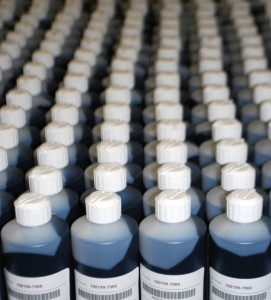The ABC’s of Ink & Foam

Looking for a custom foam and/or ink solution for your organization can be tedious endeavor with hours upon hours spent searching and researching for suppliers. In order to make your life a little easier we have set up a glossary of terms you can use as a reference or search tool.
TERMS
Closed Cell Foam: a foam consisting of numerous small sealed cavities usually filled with air.
Dye: a natural or synthetic substance used to add a color to or change the color of something.
Fade Characteristics: how quickly and to what degree a print loses brightness or vividness of color.
FDA Approved: means that a product has been tested by the FDA (Food and Drug Administration) and is deemed safe for consumer use and/or consumption.
FDA Approved Ink: are inks that have been approved by the FDA (see FDA Approved) for consumer use and/or consumption.
Fluid Metering: is the measuring or regulating the amount of fluid released.
Foam: a lightweight form of rubber or plastic made by creating spaces filled with air or a liquid within the rubber or plastic.
Foam Density: when discussing foam density the term does not refer to a foam’s weight. Foam density is a measurement of mass per unit of volume. Thus the density is a function of how the foam is made in relation to the use of additives during the mixing phase of foam production.
Foam Structure: a structure that is made out of foam
Gel/Gel Structure: plastisol based structure designed to hold a fluid and to dispense it
Ink: a colored usually liquid material for writing and printing
Ink Roll: the generic term for a substance that holds and dispenses ink
Meter: to supply in a measured or regulated amount
Nonporous Surface: a surface which is not permeable by water, air, etc.
Oil Based Ink: generic term for inks that are made from non-aqueous solvents
Open Cell Foam: a foam consisting of numerous small interconnected open cavities usually filled with air or liquid
Plastisol: blend of resin(s) and plasticizers that when heated forms a semi-solid gel like substance
Pigment: a substance that imparts black or white or a color to other materials; especially: a powdered substance that is mixed with a liquid in which it is relatively insoluble and used to impart color to coating materials (as paints) or to inks, plastics, and rubber
Polymer: a chemical compound that is made of small molecules that are arranged in a simple repeating structure to form a larger molecule
Porous Surface: is a surface that has holes (small or large) that allow air or liquid to pass through
Print Density: is a measurement of light reflected off of the print sheet.
Print Quality: a generic term referring to the over all quality of a print in relation to given specifications; does not refer to dpi
Print/metering curve: a graphical relationship of the amount of ink released at each printing episode
Substrate: a substance or layer that underlies something, or on which some process occurs
Surface Tension: the attractive force exerted upon the surface molecules of a liquid by the molecules beneath that tends to draw the surface molecules into the bulk of the liquid and makes the liquid assume the shape having the least surface area
Thermal Transfer Printing: is a digital printing process in which material is applied to the desired substrate by melting a coating of ribbon so that it adheres to the substrate
Viscosity: the property of resistance to flow in a fluid or semifluid
Water Based Ink: an ink that uses water as the primary solvent
